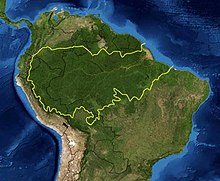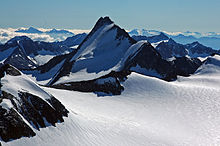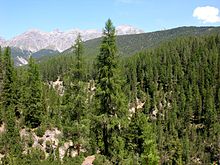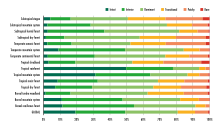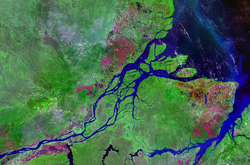Ecoregion
|
Read other articles:

J. R. R. Tolkien's mythological writings For the 2000 book, see Tolkien's Legendarium: Essays on The History of Middle-earth. Navigable diagram of more or less inclusive definitions of Tolkien's legendarium. Most of it is in Christopher Tolkien's 12-volume The History of Middle-earth published between 1983 and 1996, though that includes 4 volumes on The History of The Lord of the Rings, which stands alongside John D. Rateliff's The History of The Hobbit. The strictest definition is a selection o…

Japanese baseball player Baseball player Ryuta HeinaiYomiuri Giants – No. 66PitcherBorn: (1998-08-01) August 1, 1998 (age 25)Akashi, Hyōgo, JapanBats: RightThrows: RightNPB debutApril 20, 2021, for the Yomiuri GiantsCareer statistics (through April 3, 2022)Win–loss record0–1Earned run average13.50Strikeouts6 Teams Yomiuri Giants (2021–present) Ryuta Heinai (平内龍太, Heinai Ryuta, born August 1, 1998, in Akashi, Hyōgo, Japan) is a professional Japanese baseball …

Research institute in Slovenia The Central European Institute Søren Kierkegaard The Central European Institute Søren Kierkegaard was established after the 4th International Philosophical Symposium of Miklavž Ocepek,[1] organized by KUD Apokalipsa in June 2013 to commemorate the bicentennial of the birth of Søren Kierkegaard at the initiative of dr. Primož Repar,[2] who committed himself to the lifelong study of the thoughts of the pioneer of existentialism and is also the fi…

Disambiguazione – Tavole della Legge rimanda qui. Se stai cercando il corpo di leggi compilato nel 451-450 a.C. nel diritto romano, vedi Leggi delle XII tavole. Disambiguazione – Se stai cercando altri significati, vedi I dieci comandamenti. Questa voce o sezione sugli argomenti bibbia e religione non cita le fonti necessarie o quelle presenti sono insufficienti. Puoi migliorare questa voce aggiungendo citazioni da fonti attendibili secondo le linee guida sull'uso delle fonti. S…

この項目には、一部のコンピュータや閲覧ソフトで表示できない文字が含まれています(詳細)。 数字の大字(だいじ)は、漢数字の一種。通常用いる単純な字形の漢数字(小字)の代わりに同じ音の別の漢字を用いるものである。 概要 壱万円日本銀行券(「壱」が大字) 弐千円日本銀行券(「弐」が大字) 漢数字には「一」「二」「三」と続く小字と、「壱」「弐」…

State park in Mason County, West Virginia Tu-Endie-Wei State ParkIUCN category III (natural monument or feature)[1]Tu-Endie-Wei State Park in 2022, showing the Mansion House at left and the monument at rightLocation of Tu-Endie-Wei State Park in West VirginiaLocationMason, West Virginia, United StatesCoordinates38°50′21″N 82°08′27″W / 38.83917°N 82.14083°W / 38.83917; -82.14083Area4 acres (1.6 ha)Elevation541 ft (165 m)Established1901-10…

Voce principale: Società Sportiva Dilettantistica Pro Sesso. Associazione Calcio Pro SestoStagione 1987-1988Sport calcio Squadra Pro Sesto Allenatore Alfredo Spada poi Giancarlo Danova Presidente Giuseppe Peduzzi Serie C28° Coppa ItaliaPrimo turno Maggiori presenzeCampionato: Conte (34) Miglior marcatoreCampionato: Solimeno (15) StadioStadio Breda 1986-1987 1988-1989 Si invita a seguire il modello di voce Questa pagina raccoglie le informazioni riguardanti l'Associazione Calcio Pro Sesso …

Season of television series Vietnam IdolSeason 1Hosted byThanh ThảoJudgesSiu Black Hà Dũng Tuấn KhanhWinnerPhương VyRunner-upNgọc ÁnhFinals venueHòa Bình Theater, HCMC ReleaseOriginal networkHo Chi Minh TelevisionOriginal releaseMay 23 (2007-05-23) –October 3, 2007 (2007-10-03)Season chronologyNext →Season 2 Vietnam Idol (now retroactively known as Vietnam Idol season 1) is the first season of the interactive reality series produced in Vietnam. The show was h…

هذه المقالة بحاجة لصندوق معلومات. فضلًا ساعد في تحسين هذه المقالة بإضافة صندوق معلومات مخصص إليها. يفتقر محتوى هذه المقالة إلى الاستشهاد بمصادر. فضلاً، ساهم في تطوير هذه المقالة من خلال إضافة مصادر موثوق بها. أي معلومات غير موثقة يمكن التشكيك بها وإزالتها. (ديسمبر 2018) اللواء 1…

British Labour politician For other people named Harry Barnes, see Harry Barnes (disambiguation). This biography of a living person relies too much on references to primary sources. Please help by adding secondary or tertiary sources. Contentious material about living persons that is unsourced or poorly sourced must be removed immediately, especially if potentially libelous or harmful.Find sources: Harry Barnes Labour politician – news · newspapers · books …

American politician (born 1963) Mark AlfordOfficial portrait, 2022Member of the U.S. House of Representativesfrom Missouri's 4th districtIncumbentAssumed office January 3, 2023Preceded byVicky Hartzler Personal detailsBorn (1963-10-04) October 4, 1963 (age 60)Baytown, Texas, U.S.Political partyRepublicanSpouse Leslie Adkins (m. 1989)Children3EducationLee CollegeTexas State UniversityUniversity of Texas, Austin (attended)WebsiteHouse website Mar…

Map of the regions of Africa Africa has the world's oldest record of human technological achievement: the oldest stone tools in the world have been found in eastern Africa, and later evidence for tool production by humans' hominin ancestors has been found across West, Central, Eastern and Southern Africa.[1] The history of science and technology in Africa since then has, however, received relatively little attention compared to other regions of the world, despite notable African developm…

US indoor football league Continental Indoor Football LeagueMost recent season or competition:2014 Continental Indoor Football League seasonContinental Indoor Football League logoFormerlyOhio-Penn Indoor Football LeagueGreat Lakes Indoor Football LeagueSportIndoor footballFounded2005FounderEric SpitaleriJeff SpitaleriCory TrappFirst season2006Owner(s)Stuart SchweigertJim O'BrienRob LichtCountryUnited StatesMost recentchampion(s)Erie Explosion (2nd title)Most titlesCincinnati CommandosErie Explos…

Galaxy in the constellation Centaurus NGC 4709legacy surveys image of NGC 4709 (large galaxy in the middle), as well as other galaxies of the Centaurus Cluster, including NGC 4706.Observation data (J2000 epoch)ConstellationCentaurusRight ascension12h 50m 03.9s[1]Declination−41° 22′ 55″[1]Redshift0.015604[1]Heliocentric radial velocity4678 km/s[1]Distance150 Mly (45 Mpc)[2]Group or clusterCentaurus Cluster (Cen 45 subg…
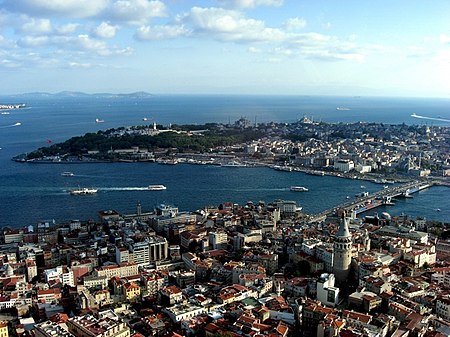
World Heritage Sites in Turkey Historic Areas of IstanbulUNESCO World Heritage SiteFrom left to right: The Seraglio Point consisting of the Topkapı Palace and the Sea Walls; the Hagia Sophia; the Sultan Ahmed Mosque; and the Galata Tower in the foreground, across the Golden Horn.LocationIstanbul, TurkeyIncludes Sultanahmet Urban Archaeological Component Area Süleymaniye Mosque and its Associated Component Area Zeyrek Mosque (Pantocrator Church) and its Associated Component Area Istanbul Land W…
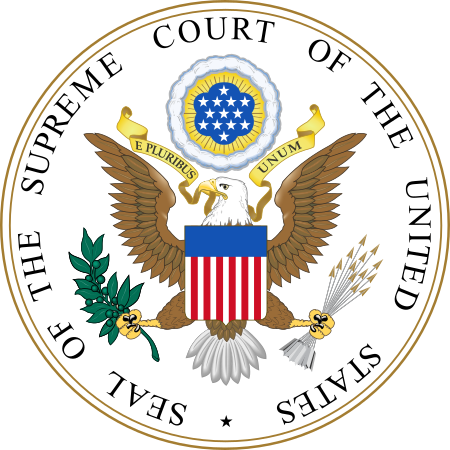
Supreme Court of the United States38°53′26″N 77°00′16″W / 38.89056°N 77.00444°W / 38.89056; -77.00444EstablishedMarch 4, 1789; 235 years ago (1789-03-04)LocationWashington, D.C.Coordinates38°53′26″N 77°00′16″W / 38.89056°N 77.00444°W / 38.89056; -77.00444Composition methodPresidential nomination with Senate confirmationAuthorized byConstitution of the United States, Art. III, § 1Judge term lengthlife …

Il CortegianoAltri titoliIl libro del Cortegiano Edizione del 1559 AutoreBaldassarre Castiglione 1ª ed. originale1528 Generesaggio Lingua originaleitaliano AmbientazioneCorte di Urbino PersonaggiElisabetta Gonzaga, Emilia Pio, Gaspare Pallavicino, Federico Fregoso, Ottaviano Fregoso, Morello da Ortona, Roberto da Bari, Pietro Bembo, Giuliano de' Medici (il Magnifico Iuliano), Niccolò Frigio, il Bibbiena (Bernardo Dovizi), l'Unico Aretino, Cesare Gonzaga, Ludovico da Canossa, Ludovico Pio,…

Motor vehicle Fiat Tipo 70OverviewManufacturerFiatProduction1915–1920Body and chassisBody styleSedanLayoutFR layoutPowertrainEnginestraight-4 2001 cc[1]Transmission4-speed manualDimensionsWheelbase2,706 mm (107 in)[1]Length3,820 mm (150 in)[1]Curb weight1,735 kg (3,825 lb)[1]ChronologyPredecessorFiat ZeroSuccessorFiat 501 The Fiat 70 was a car produced by Italian car manufacturer Fiat between 1915 and 1920. The 70 use…

Election for the lieutenant governorship of Nebraska 1932 Nebraska lieutenant gubernatorial election ← 1930 November 8, 1932 1934 → Nominee Walter H. Jurgensen Theodore W. Metcalfe Party Democratic Republican Popular vote 280,657 245,756 Percentage 52.2% 45.7% Lieutenant Governor before election Theodore W. Metcalfe Republican Elected Lieutenant Governor Walter H. Jurgensen Democratic Elections in Nebraska Federal offices Presidential elections 1868 1872 1876 18…

1924 film by William Beaudine This article needs a plot summary. Please add one in your own words. (March 2021) (Learn how and when to remove this message) A Self-Made FailureLobby cardDirected byWilliam BeaudineWritten byTamar Lane (adaptation)Violet Clark (scenario)Lex Neal (scenario)John Grey (scenario)Story byJ. K. McDonaldProduced byJ. K. McDonaldStarringLloyd HamiltonCinematographyRay JuneBarney McGillEdited byH. P. BrethertonBeth MatzDistributed byAssociated First National PicturesRelease…
